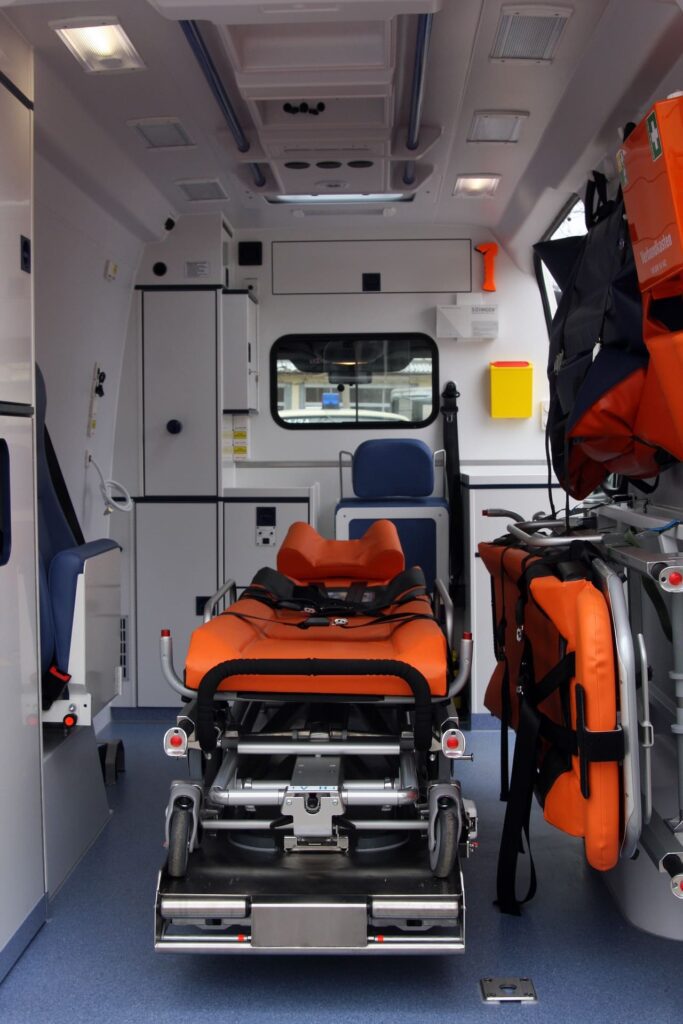
Airlines Stretcher Booking Services | Air Ambulance Solution
An Airlines Stretcher is a medical stretcher specifically designed for use during air travel. It allows patients who require medical assistance to be safely transported on a commercial flight. These stretchers are specially equipped to fit within the plane’s seating configuration, ensuring the patient’s comfort and safety throughout the journey. Airlines stretchers are commonly used for patients who are too ill or injured to sit in a regular seat, such as those in need of continuous monitoring or emergency treatment. The stretcher provides a secure space where medical personnel can attend to the patient while the plane is in the air.
Benefits of Using a Commercial In-Flight Stretcher
Opting for a commercial in-flight stretcher comes with several advantages, particularly for those who need to travel long distances under medical supervision:
- Comfort and Safety: Airlines stretchers are designed to ensure the patient is comfortable and stable throughout the flight. They come with safety straps and padding to minimize discomfort and risk.
- Medical Supervision: With the ability to accommodate medical equipment and staff, patients can receive continuous monitoring, including life support if necessary.
- Cost-Effective: Compared to dedicated air ambulance services, booking a stretcher on a commercial flight is a more affordable alternative for patients who don’t require intensive care.
- Flexibility: Commercial airlines offer regular routes, so patients can reach international or remote destinations without waiting for a specialized air ambulance.
- Reliable and Trusted Airlines: Airlines provide experienced crew members, ensuring a safe and professional flight experience. This reduces stress for both the patient and their family.
What Challenges You Can Consider?
While using a commercial in-flight stretcher offers many benefits, there are some challenges to consider:
- Limited Space: Commercial flights have a fixed amount of space. The stretcher will take up a row of seats, and the space available for medical staff and equipment might be constrained.
- Medical Clearance: Depending on the airline and the patient’s condition, obtaining medical clearance is necessary before booking a stretcher.
- Flight Duration: Long flights can be taxing on patients, especially those with severe medical conditions. Ensure that the flight duration aligns with the patient’s stability.
- Limited Emergency Support: While airlines have trained crew members, they cannot provide the same level of medical care that an air ambulance would. Critical cases may not be suitable for this mode of transport.
- Booking Process: The process of booking a stretcher involves coordination between the patient, medical staff, and airline, which may require time and effort.

Airlines Stretcher Booking Process
Booking an Airlines Stretcher involves several key steps to ensure a smooth and safe journey for the patient:
- Consultation: The first step is to consult with a medical professional to assess the patient’s needs and determine if they are fit for air travel. This will help determine whether a stretcher is the right option.
- Choose the Airline: Depending on the patient’s medical requirements and destination, you’ll need to choose a suitable airline that offers stretcher services. Not all airlines provide this facility, so research is crucial.
- Submit Medical Clearance: Airlines require medical clearance before confirming the stretcher booking. This typically involves submitting a medical certificate from the patient’s doctor that explains their condition and treatment plan.
- Booking the Stretcher: Once the airline is chosen, the stretcher must be booked in advance. You’ll need to provide details such as the patient’s condition, flight dates, and any special requirements for medical equipment or care.
- Coordinate with Medical Team: You’ll need to arrange for medical personnel (nurses, doctors, or paramedics) to accompany the patient on the flight. Some airlines may provide medical staff, but often it’s necessary to arrange this separately.
- Prepare for the Journey: Ensure all necessary medical supplies are packed, including medications, oxygen, and any medical devices the patient may need. Double-check that all documents, including medical clearance, are in order.
- Flight Day: On the day of the flight, ensure that the patient arrives at the airport early to allow time for check-in and medical preparations. Medical staff will need to assist in transferring the patient onto the stretcher and ensure they are stable before takeoff.
Conclusion
Using an Airlines Stretcher for air travel provides a viable, affordable alternative to air ambulances for those who need medical care while flying. It offers flexibility, safety, and comfort for patients who must travel long distances but do not require intensive care. By understanding the booking process and challenges, you can ensure a smooth and well-coordinated journey for both the patient and their family.
Frequently Asked Questions (FAQs)
Ans. To book an air ambulance, contact our customer service team. We will assess your needs, coordinate the logistics, and arrange the necessary medical and flight details.
Ans.It is recommended to book at least 72 hours in advance, but it’s always best to do so as early as possible to ensure availability and adequate medical clearance.
Ans.Most airlines require you to arrange for medical personnel to accompany the patient. Some airlines offer trained medical staff, but this is often at an additional cost and should be confirmed in advance.
Ans. The cost of booking a stretcher on a commercial flight varies depending on the airline, route, and medical requirements. It is typically more affordable than an air ambulance but still involves additional fees for the stretcher, medical support, and other services.
Ans. In-flight medical support can assist with minor emergencies, but if the patient’s condition deteriorates significantly, the airline crew will follow emergency protocols. It’s important to assess the patient’s health prior to booking to ensure that a commercial flight is the right choice.



